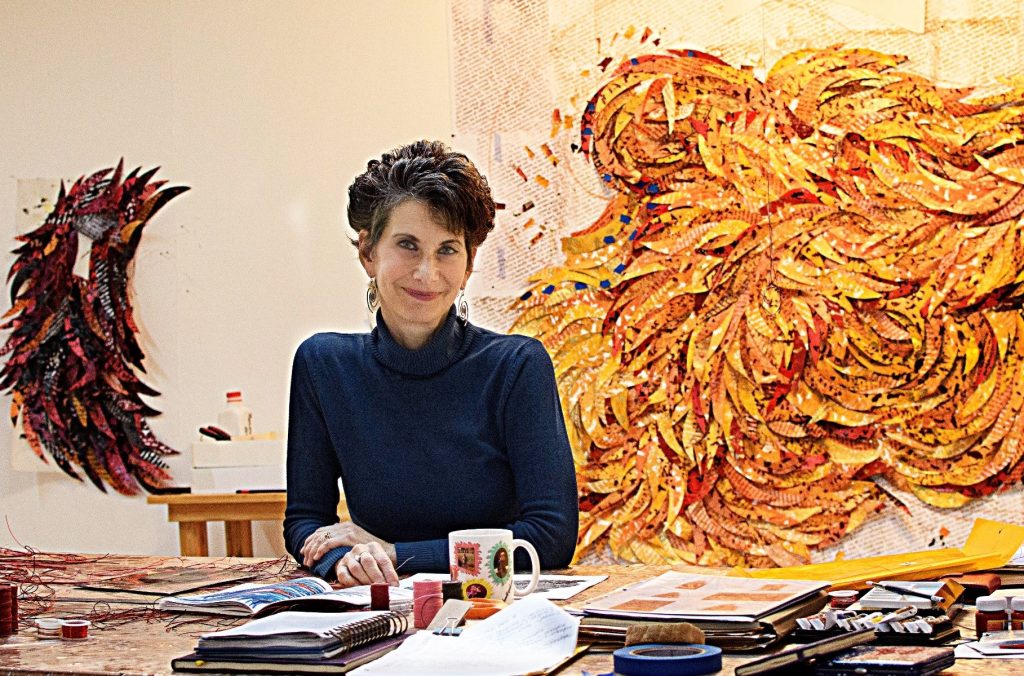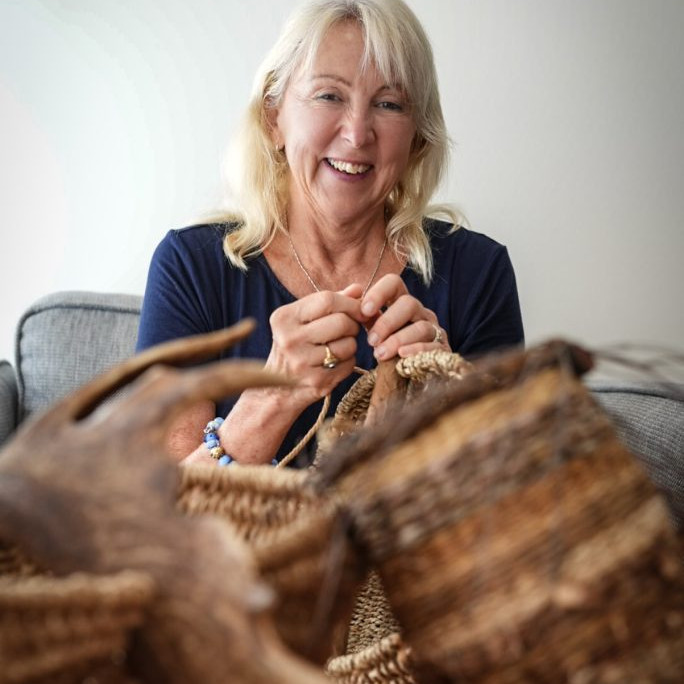Deborah Kruger Eco / Textile Artist - Mexico / USA
Deborah Kruger, Chapala, Mexico
Deborah Kruger’s inspiration is taken from bird migrational patterns. Kruger’s work is a story, interwoven with beauty, glamour and a social conscience.
Zoneone Arts brings Deborah Kruger to you…
Explain where and how you developed the idea of ‘Feather Art Series’?
Where did the idea come from?

Box of fused plastic feathers
Like many artists, ideas often emerge unconsciously and organically. For many years in the late 90s, I restricted myself to using a triangular format. In one piece, I found myself using scraps from an earlier piece and attaching them in slender triangular flaps. There was something featherlike that appealed to me and I began to use this concept in subsequent pieces. Over time, I identified these strips as feathers and their shape slowly changed from triangles into undulating feather-like shapes. Since I am an abstract artist, I haven’t sought to create realistic feathers, but rather to evoke the sense of a feather.

New feathers, screen printed on fused plastic bags.
How did you come across it?
Back in the 90s, I was a single mother, working full-time at a day job and had almost no studio time. To maximize those few precious hours a week, I gave myself a rather strict assignment as a way to eliminate decision-making and focus my creative output. The assignment included the following aspects:
Shape: needed to be triangular (an outgrowth of earlier art quilting work)
Colour: used a palette that evoked a forest floor
Materials: used encaustic, oilstick and waxed linen thread because they were sensuous and pleasurable
Concepts: limited myself to no more than five visual concepts per piece
Evaluation: forbade myself from explaining what the work meant
These restrictions were intended to streamline my creative time and I adhered to them for 10 years. The ensuing body of work was visually cohesive, and I succeeded in eliminating obstacles to creativity.
What mediums have you used?
Until recently, I used drawing, stitching and painting as my primary mediums. I dabbled in art quilting, soft pastels and mixed media before settling on using encaustic and oilstick.
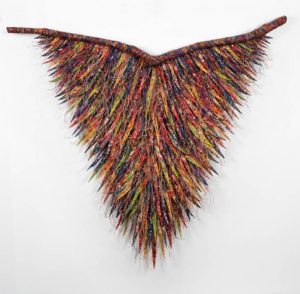
Enrapture, 2008; 99 x 107cm; fibre, encaustic, oilstick, waxed linen, wire threa
Can you expand how you combine textiles and encaustic?
Most encaustic artists use this wonderful media in a painting context. Since I have such strong roots in fibre, it seemed natural to combine these materials. For me, encaustic was always more textural than simply a form of painting. I enjoyed using it for gestural mark-making. My experience using natural dyes early in my career laid a foundation for mixing my own encaustic colours rather than using pre-mixed colorsticks. I never seem to do things the easy way! Mixing encaustic allowed me a more nuanced approach to colour.
Discuss how you are using recycled materials rather than textiles in your current work.
As my work and ideas evolved, I realized that the abstract mark-making on my feathers was not speaking clearly about the issues of habitat destruction, migration and bird extinction. Although it was very painful to leave what I was doing, I had to stop and reconsider how to create work that spoke more specifically about these issues while remaining abstract, no easy task! It took me a year of research to develop my current technique of screen-printing on fused plastic bags. During this time, I also developed designs based on drawings I did of endangered birds. By incorporating these images, I was able to embed real information about my concerns. When I cut up these sheets of printed plastic into feathers, I can offer the information and text relevant to my concerns in an abstract format that satisfies my aesthetics. The new work is neither painting nor sculpture, but an amalgam that is layered, textured and visually appealing while carrying its subliminal message.
Expand in the text within this work, include in this some background into Rachel Carson.
I read Silent Spring for the first time as a teenager and it made an indelible impression. I was shocked to learn about how DDT was killing birds. I lost my innocence as I realized that corporations put profit before principles with no thought to the impact on the world we all shared. The book forged me as an activist and futurist. Sometimes ideas need a long gestation period before taking root. Now it’s easy to see how it lodged in my system and gave birth to my current work.
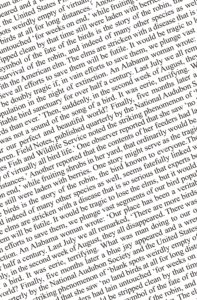
Silk screen of Rachel Carson
Expand on the legal aspects of using Rachel Carson’s quotes.
Technically, Rachel Carson’s work will enter the public domain in January 2019. I am using fragments of her work in text that I overprint on my feathers. Like a writer, I use my text as footnotes to my work but as an abstract artist, the text is not meant to be read, but rather to evoke the spirit of her work and imbue it in mine.
What are your favourite quotes from Rachel Carson that keep you working?
“The question is whether any civilization can wage relentless war on life without destroying itself, and without losing the right to be called civilized.”
― Rach Carsonel
“The more clearly we can focus our attention on the wonders and realities of the universe about us, the less taste we shall have for destruction.”
― Rachel Carson
Briefly take us through the process of ‘Flourish’.
Flourish is an important transitional piece in my current series. As I began to use the fused plastic feathers, I imagined a long horizontal piece constructed of several 76 x 76 cm squares. I always need to think ahead about shipping, so I thought it would be easier to pack a stack of smaller squares that would hang as a larger piece. It looked like a good concept on paper, but I was not pleased with the actual string of pieces, so I abandoned the idea. As I started developing the map shapes I am using, I wanted to experiment with texture since that has always been so important to me. I pulled out some of these earlier squares and decided to play with them. I cut one in half and started tying in waxed linen and wire thread, a technique that I love using because it creates a haze of colour and texture. Slowly the piece began to curve. Since I was not attached to the outcome, I carved into it and let Flourish evolve into its eventual curving shape. I believe that pieces have a life and intelligence of their own and that at some point, you need to allow them to become what they want to become without trying to control the process (kind of like a child!). Flourish is a great example of how I work with my creative process.

Flourish; 2017; screen-printing on fused plastic bags, sewing, waxed linen, wire thread
You have won many Grants, Honours, and Residencies, discuss one that has had a dramatic influence on you career.
Spending a month in France for the first time in 2016 at La Porte Peinte Centre pour les Arts (http://laportepeinte.com/) located in Noyers-sur-Serein, a medieval village in the wine country of Burgundy was a turning point for me as an artist. I run an artist residency program here in Mexico (www.360xochiquetzal.com) and at that point, I had not achieved the work/life balance I now enjoy. I needed uninterrupted time to do more research about endangered birds and think more deeply about my work. Being away from my home and work responsibilities was profound. Although I hadn’t intended to make art, but rather think about it, I was nonetheless pulled to draw these rapidly disappearing birds. It felt like I was drawing them back to life. I completed a series of 18 drawings during that month and they have become the basis of many of the subsequent silk-screen designs and other related work.
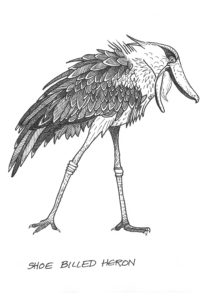
Drawing of Shoe Billed Heron
Talk about your own migration pattern and what lead to your move to Mexico.
I come from an Eastern European Jewish family that migrated to the United States and Argentina to escape persecution. Jewish history is shaped by similar migrations, so I imagine it is ingrained into my DNA. I grew up in New York City, but migrated to New England for work in textile design (before that field migrated south and eventually to Southeast Asia). I spent most of my adult life in Western Massachusetts until I moved to Mexico in 2010. At that time, it seemed like Mexico would be the answer to some serious financial setbacks. Now, however, I look back and see it differently. It’s as if the universe was conspiring to push me out of the United States and into a country and culture that would allow me to finally realize my dream of working as a full-time studio artist.
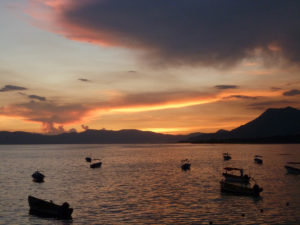
Lake Chapala
Birds migrate in numbers but there is a similarity to the Textile community, discuss this by taking 2 other textile artists who have influenced your current work.
Once you look at the work by Naomi Wanjiku Gakunga (https://naomiwanjiku.com/), you will see why it inspires me. In fact, Naomi herself has been a personal influence and mentor. Born in a little village in Kenya, Naomi observed how the new sheet metal roofs aged, and she mirrors these weathering effects in her own artistic process. The impact of this local material has resurfaced in her artwork in a similar way as the impact of Rachel Carson’s writing bubbling up in mine after many years of lying dormant. Her early exposure to African aesthetics and various textile techniques has given way to sophisticated work in aged and painted sheet metal that still manages to have a textile sensibility. Naomi initially came to the United Stated to attend graduate school at the University of California, Los Angeles, and has made San Antonio, Texas her home.

The Girls Dance by Naomi Wanjiku
Naomi Wanjiku Gakunga | Ndumo- The Girls’ Dance (2015)
https://goo.gl/images/9NCfgr
Olga de Amaral has been a major influence and inspiration for over thirty years (www.olgadeamaral.com/). Born and educated in Bogota, Colombia, Olga had the opportunity to study at Columbia University and Cranbrook Academy in the United States. After her marriage to sculptor Jim Amaral, they lived and worked in Spain and France for many years. Olga’s work evolved from loom weaving to complex sculptural artwork. The influence of her country of origin is deeply embedded in her work, especially the works using gold and silver. Her exposure to international art and artists has positioned her as a major leader in the field of contemporary abstract fibre. She has returned to Bogota and is considered a national treasure in Colombia.
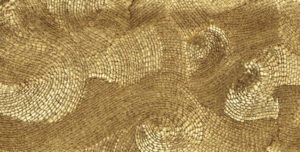
Image: Olga de Amaral
Nohra Haime Gallery: Olga de Amaral – galleryIntell
https://goo.gl/images/PtGbVz
You comment, “Whenever I travel, I try to tuck in visits to galleries and museums that nourish me creatively” discuss the importance of this to your work.
I live in a small pueblo where there isn’t a big art scene. I feel very inspired when I spend time seeing art in museums and galleries. If I love the work, it incites me to make more. If I hate the work, it challenges me to make better work. Either way, I get to see what artists are doing. It helps me to think outside the box and imagine larger and more daring work. Recently, I have begun to use Instagram to follow artists throughout the world. Some of my favourites are in Australia like Avital Sheffer, who is an exceptional ceramic artist working on the North Coast of NSW.
How has your move to Mexico allowed you to do BIGGER work?
Mexico has provided me with resources that I never had in the United States. I built a huge studio that can accommodate large-scale work and sculpture at a fraction of the cost. I have a team of six Mexican women who help me sew, fuse, silk-screen, cut out and organize my feathers. I pay them handsomely for their work, provide a safe and enjoyable work environment and expose them to the artist’s life. I can afford a full-time studio assistant who handles correspondence, proposals, design projects and prototyping, managing my production team. None of this would have been possible in the U.S. Being here has allowed me to realize work that had only previously existed in my imagination.
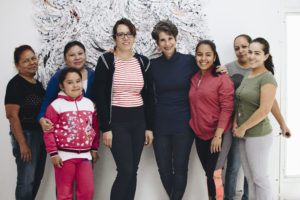
Deborah and studio team
Have you thought of transferring your art into smaller wearable art?
Many people have asked me about creating wearable art or jewellery. Although I studied at FIT, I wasn’t in the fashion end of design and don’t feel drawn to these forms. However, my latest show has a floor installation made with broken plates that I designed with images of endangered birds and that has given me the idea to create a line of home décor using my drawings. Stay tuned!

Broken; 2018; 203 diameter x 28; shards of hand-painted ceramic plates and building rubble
How has your formal training in textiles influenced your work over the many years?

Plumage 2; 2003; 37 x 37; fibre, encaustic, oilstick, paint
I not only studied textile design at FIT in New York City, but I also come from a family of sewers, knitters and designers. I made all my clothes until I had a job. Like migration, textiles are in my blood. I am drawn to the texture, hand and smell of fabric. Although I am now using plastic, it is still sewn, and textiles continue to echo through the work.
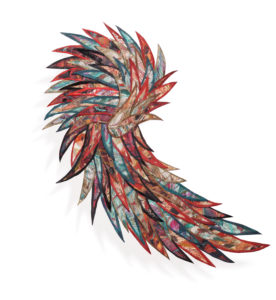
Halcyon; 2010; 50 x 33; fibre, encaustic, oilstick, paint
Your work is so fluid and tactile how do you recommend the owners care for it?
Now that my new work is made with plastic, it isn’t framed but can easily be dusted. The plastic doesn’t fade like fabric and is less sensitive to light exposure. I think it’s a better option for most homes and businesses.

Missing; 2018; 118 x 132 x 2.5; screen-printing on fused plastic bags, sewing
Deborah has just finished a documentary about her work and it Zoneone Arts is pleased to share it with you.
Contact details:
Deborah Kruger
Email: deborahkrugerstudio@gmail.com
Website: www.deborahkruger.com
Deborah Kruger, Mexico / USA
Interview by Deborah Blakeley, September 2018
Think a colleague or friend could benefit from this interview?
Knowledge is one of the biggest assets in any business. So why not forward this on to your friends and colleagues so they too can start taking advantage of the insightful information the artist has given?
Other artists you may be interested in:


